|
|

Khajurao
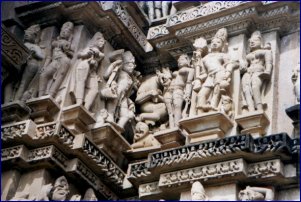
In the temple architecture of
India, the Khajuraho complex remains unique. One thousand years ago, under the
generous and artistic patronage of the Chandela Rajput kings of Central India,
85 temples, magnificent in form and richly carved, came up on one site, near the
village of Khajuraho. The amazingly short span of 100 years, from 950 AD - 1050
AD, saw the completion of all the temples, in an inspired burst of creativity.
Today, of the original 85, only 22 have survived the ravages of time; these
remain as a collective paean to life, to joy and to creativity; to the ultimate
fusion of man with his creator.
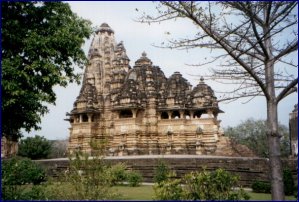 Why did the Chandelas choose Khajuraho or Khajirvahila - garden of dates, as
it was known then - as the site for their stupendous creations ? Even in those
days it was no more than a small village. It is possible given the eclectic
patronage of the Chandelas and the wide variety of beliefs represented in the
temples, that they had the concept of forming a seat of religion and learning at
Khajuraho. It is possible that the Chandelas were also believers in the powers
of Tantrism; the cult which believes that the gratification of earthly desires
is a step closer to the attainment of the infinite. It is certain however, that
the temples represent the expression of a highly matured civilization. Why did the Chandelas choose Khajuraho or Khajirvahila - garden of dates, as
it was known then - as the site for their stupendous creations ? Even in those
days it was no more than a small village. It is possible given the eclectic
patronage of the Chandelas and the wide variety of beliefs represented in the
temples, that they had the concept of forming a seat of religion and learning at
Khajuraho. It is possible that the Chandelas were also believers in the powers
of Tantrism; the cult which believes that the gratification of earthly desires
is a step closer to the attainment of the infinite. It is certain however, that
the temples represent the expression of a highly matured civilization.
Yet another theory is that the erotica of
Khajuraho, and indeed of other
temples, had a specific purpose. In those days when boys lived in hermitages,
following the Hindu law of being "brahmacharis" until they attained
manhood, the only way they could prepare themselves for the worldly role of
'householder' was through the study of these sculptures and the earthly passions
they depicted.

Not To Miss:
While on the visit to Khajuraho don't forget to
see the Sound and Light Show that is held every evening. The duration of the
show is 50 mins. The narrator of the documentary which is in bothe Hindi/English
is ,
the Great Super Star of India.
Places to See
 The architectural style of the Khajuraho temples is very different from the
temple prototype of that period. Each stands, instead of within the customary
enclosure, on a high masonry platform. Combined with the upward direction of the
structure, which is further accentuated by vertical projections, the total
effect is one of grace and lightness, reminiscent of the Himalayan peaks. Each
of the chief compartments has its own roof, grouped in such a way that the
highest is in the centre, the lowest over the portico, a triumph of skill and
imagination in recreating the rising peaks of a range.
The architectural style of the Khajuraho temples is very different from the
temple prototype of that period. Each stands, instead of within the customary
enclosure, on a high masonry platform. Combined with the upward direction of the
structure, which is further accentuated by vertical projections, the total
effect is one of grace and lightness, reminiscent of the Himalayan peaks. Each
of the chief compartments has its own roof, grouped in such a way that the
highest is in the centre, the lowest over the portico, a triumph of skill and
imagination in recreating the rising peaks of a range.
The temples of Khajuraho are divided into three geographical groups :
Western, Eastern and Southern. The Western group is certainly the best known,
because it is to this group that the largest and most typical Khajuraho temple
belongs : the Kandariya Mahadev. Perfectly symmetrical, it soars 31
km high. Though the four temples that stand at the corners of the main shrine
are now in ruins, the main shrine has an exquisitely carved entrance arch with a
multitude of themes. Celestial beings, lovers serenading musicians . . .
movements captured in stone, frozen in time, yet retaining a quality of warm,
pulsating life. The very stone seems to have taken on the living, breathing
quality of the carved figures.
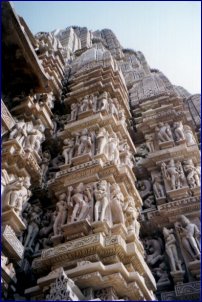
Beyond the archway of the Kandariya
Mahadev, lie the six interior
compartments; the portico, main hall, transept, vestibule, sanctum and
ambulatory. The ceilings are particularly noteworthy and the pillars supporting
them have intricately carved capitals. The transept's outer walls have three
horizontal panels showing deities of the Hindu pantheon, and groups of lovers, a
pageant of sensuousness, vibrantly alive.
Also in the western group is the Chaunsat Yogini, the only
granite temple in the Khajuraho group. Dedicated to Kali, it is also unique in
being quadrangular in plan. Only 35 of the original 65 cells remain and no image
of Kali has survived : not surprisingly, since this is the earliest surviving
shrine of the group dated to 900 AD. Another Kali Temple (originally dedicated
to Vishnu) is the Devi Jagadambe Temple.
North of it facing eastward to the rising sun, is the Chitragupta
temple, dedicated to the sun-god, Surya. The image of this powerful deity in
the inner sanctum is particularly imposing : 5ft high, and driving a
seven-horsed chariot. The group scenes depicted are equally spectacular: royal
processions, elephant-fights, hunting scenes, group dances. The lavish
lifestyle of the Chandela kings and their court is here in all its pomp and
glory. Similar in plan to the Kandariya Mahadev is the Vishwanath Temple.
Lions flank the northern steps and elephants the southern, leading up to the
temple. Within, there is an impressive three headed image of Brahma. The
exteriors are profusely carved, and facing the shrine is a Nandi Temple
with a massive, 6 ft high Nandi bull.
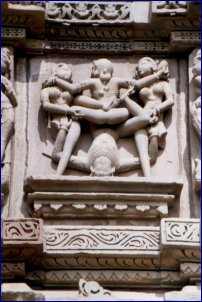 Since the first few Chandela rulers were devotees of Vishnu, there are
some important Vaishnavite temples in the Khajuraho group, the finest of which
is the Lakshmana Temple. The lintel over the entrance shows the trinity
of Brahma, Vishnu and Shiva, with Lakshmi, Vishnu's consort. The sanctum is
richly carved and has a three-headed idol of Vishnu's incarnations, Narsimha and
Varaha. The boar incarnation also appears in another Vaishnavite shrine,
the Varaha Temple. The statue here is a mammoth 9 ft high one, its
surface covered with figures from the Hindu Pantheon. Since the first few Chandela rulers were devotees of Vishnu, there are
some important Vaishnavite temples in the Khajuraho group, the finest of which
is the Lakshmana Temple. The lintel over the entrance shows the trinity
of Brahma, Vishnu and Shiva, with Lakshmi, Vishnu's consort. The sanctum is
richly carved and has a three-headed idol of Vishnu's incarnations, Narsimha and
Varaha. The boar incarnation also appears in another Vaishnavite shrine,
the Varaha Temple. The statue here is a mammoth 9 ft high one, its
surface covered with figures from the Hindu Pantheon.
The Khajuraho temples are no longer living places of worship, with a few
exceptions. The Matangeswara Temple for example is still a place of
worship. Dedicated to Shiva it has an 8 ft high lingam. South of this temple is
the open air Archaeological Museum, which has a beautiful displayed
collection of statues and friezes collected from the area : the remains of long
vanished temples
Hindu and Jain temples make up the Eastern Group, which lies close to
the Khajuraho village. The largest Jain temple, Parswanath, is in this
group. Exquisite in detail, the sculptures on the northern outer wall make this
temple perhaps the finest in the group. The themes of these carvings are the
timeless ones of every day, mortal activity. A woman sits bent pensively on a
letter, a lovely young girl removes a thorn from her foot, the master craftsmen
of Khajuraho display here their deep understanding of the trifles that make up a
human life. Within, the sanctum has a throne, which faces a bull : emblem of the
first tirthankara, Adinath. The actual image of Parswanath from which the temple
derives its name was installed as recently as 1860.
 The other Jain temple in this group is the Ghantai Temple. Though
almost in ruins now, it still bears evidence of its original splendour.
Particularly, arresting is the frieze which depicts, in graphic detail, the 16
dreams of Mahavira's mother and a multi-armed Jain goddess riding on a winged
Garuda. North of Parswanatha is the more modestly sized Adinatha Temple. The other Jain temple in this group is the Ghantai Temple. Though
almost in ruins now, it still bears evidence of its original splendour.
Particularly, arresting is the frieze which depicts, in graphic detail, the 16
dreams of Mahavira's mother and a multi-armed Jain goddess riding on a winged
Garuda. North of Parswanatha is the more modestly sized Adinatha Temple.
The three Hindu temples in the Eastern Group are the Brahma, Vamana
and Javari Temples. A double row of apsaras, celestial nymphs, adorn the
outer walls of the Vamana temple. A variety of sensuous attitudes : languid,
provocative, mischievously inviting, give credibility to the theory that
Khajuraho's erotica were meant to test the devotees who came to worship their
gods at the temples.
5 km from the Khajuraho village, lies the Southern Group of temples. The fine Chaturbhuj
Temple in this group has a massive intricately carved image of Vishnu in the
sanctum. Duladeo Temple, another of the southern group, is a little away
from the road to the Jain group of temples.
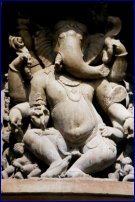
Though remains of temples belonging to the Khajuraho group have been discovered
at Jatkari, 3 km away and even at Maribag in Rewa, it is at the 3 main groups
that the imperishable glory of Khajuraho, the sensuous celebration of life, the
aspiration towards the infinite, remains.
.
Orchha's
grandeur has been captured in stone, frozen in time, a rich legacy to the
ages. In this medieval city, the hand of time has rested lightly and the
palaces and temples built by its Bundela rulers in the 16th and 17th
centuries retain much of their pristine perfection.

Orchha
was founded in the 16th century by the Bundela Rajput chieftain, Rudra
Pratap, who chose this stretch of land along the Betwa river as an ideal
site for his capital. Of the succeeding rulers, the most notable was Raja
Bir Singh Ju Deo who built the exquisite Jehangir Mahal, a tiered palace
crowned by graceful chhatris. From here the view of soaring temple spires
and cenotaphs is spectacular.
Complementing
the noble proportions of their exteriors are interiors which represent the
finest flowering of the Bundela school of painting. In the Laxminarayan
Temple and Raj Mahal, vibrant murals encompassing a variety of religious
and secular themes, bring the walls and ceilings to rich life.
Top
|
|



